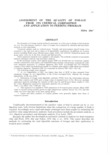Development of a forage testing method is necessary as a first step to design a feed program for cow. For this purpose, nutritive value of forages was evaluated by chemical and enzymatic methods in this experiment.
Temperate grasses such as orchard grass, Timothy and grass-legume mixed forage were prepared to hay and were fed to sheep in 19 digestibility experiments. In addition, six tropical grasses including Bahia grass, Rhodes grass, finger millet, fall panicum, Makarikari grass, and green panic were cut at the first, second and third growth.
Three analytical methods were applied to all samples. The methods consisted of proximate analysis, detergent analysis and enzymatic analysis.
In the enzymatic system, feed organic matter (OM) was divided into two fractions, organic cellular content(OCC) and organic cell wall(OCW)using amylase and protease. Isolated cell walls were subjected separately to cellulase digestion; thus OCW was divided into two fractions, organic a (Oa) which was hydrolysed rapidly by cellulase, and organic b (Ob) which was resistant to cellulase digestion. Therefore OM was expressed as follows: OM =OCC+Oa +Ob.
The following results were obained.
1 In vivo digestibility of OCC was higher than that of OCW in hays prepared from temperate forages. In vivo digestibility of Oa of hays averaged 93.9%, whereas the average digestibility of Ob was 42.0%.
2 Estimation of forage total digestible nutrients (TDN) from the relationship between crude fiber contents and TDN gave a large value of standard error (5.2%). However multiple regression equation including the contents of OCC plus Oa and Ob gave better results (r= 0.93, Se=2.4%). Regression equation by enzymatic analysis was as follows:
TDN =1.111 (OCC+Oa)+0.605 Ob-18.8.
3 This equation was applied to TDN estimation of 18 tropical grass samples. Mean TDN value of second cutting grasses grown in high temperature summer season was 57% and this value was lower than that of the first cutting (61%).
4 Lignin and silica contents of tropical grasses were generally higher than those of temperate grasses.

